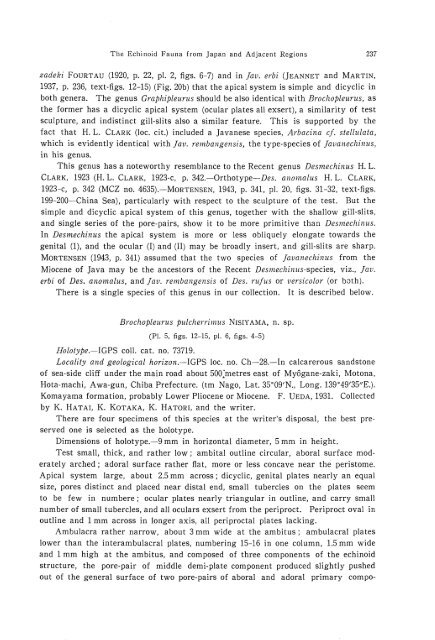the echinoid fauna from japan and adjacent regions part i
the echinoid fauna from japan and adjacent regions part i
the echinoid fauna from japan and adjacent regions part i
You also want an ePaper? Increase the reach of your titles
YUMPU automatically turns print PDFs into web optimized ePapers that Google loves.
The Echinoid Fauna <strong>from</strong> Japan <strong>and</strong> Adjacent Regions 237<br />
zadeki FOURTAU (1920, p. 22, pI. 2, figs. 6-7) <strong>and</strong> in jav. erbi (JEANNET <strong>and</strong> MARTIN,<br />
1937, p. 236, text-figs. 12-15) (Fig. 20b) that <strong>the</strong> apical system is simple <strong>and</strong> dicyclic in<br />
both genera. The genus Graphipleurus should be also identical with Brochopleurus, as<br />
<strong>the</strong> former has a dicyclic apical system (ocular plates all exsert), a similarity of test<br />
sculpture, <strong>and</strong> indistinct gill-slits also a similar feature. This is supported by <strong>the</strong><br />
fact that H. L. CLARK (loc. cit.) included a Javanese species, Arbacina cf. stellulata,<br />
which is evidently identical with jav. rembangensis, <strong>the</strong> type-species of javanechinus,<br />
in his genus.<br />
This genus has a noteworthy resemblance to <strong>the</strong> Recent genus Desmechinus H. L.<br />
CLARK, 1923 (H. L. CLARK, 1923-c, p. 342.-0rthotype-Des. anomalus H. L. CLARK,<br />
1923-c, p. 342 (MCZ no. 4635).-MoRTENSEN, 1943, p. 341, pI. 20, figs. 31-32, text-figs.<br />
199-200-China Sea), <strong>part</strong>icularly with respect to <strong>the</strong> sculpture of <strong>the</strong> test. But <strong>the</strong><br />
simple <strong>and</strong> dicyclic apical system of this genus, toge<strong>the</strong>r with <strong>the</strong> shallow gill-slits,<br />
<strong>and</strong> single series of <strong>the</strong> pore-pairs, show it to be more primitive than Desmechinus.<br />
In Desmechinus <strong>the</strong> apical system is more or less obliquely elongate towards <strong>the</strong><br />
genital (1), <strong>and</strong> <strong>the</strong> ocular (I) <strong>and</strong> (II) may be broadly insert, <strong>and</strong> gill-slits are sharp.<br />
MORTENSEN (1943, p. 341) assumed that <strong>the</strong> two species of javanechinus <strong>from</strong> <strong>the</strong><br />
Miocene of Java may be <strong>the</strong> ancestors of <strong>the</strong> Recent Desmechinus-species, viz., jav.<br />
erbi of Des. anomalus, <strong>and</strong> jav. rembangensis of Des. rufus or versicolor (or both).<br />
There is a single species of this genus in our collection. It is described below.<br />
Brochopleurus pulcherrimus NISIY AMA, n. sp.<br />
(Pl. 5, figs. 12-15, pl. 6, figs. 4-5)<br />
Holotype.-IGPS colI. cat. no. 73719.<br />
Locality <strong>and</strong> geological horizon.-IGPS loco no. Ch-28.-In calcarerous s<strong>and</strong>stone<br />
of sea-side cliff under <strong>the</strong> main road about 500:metres east of My6gane-zaki, Motona,<br />
Hota-machi, Awa-gun, Chiba Prefecture. (tm Nago, Lat. 35°09'N., Long. 139°49'35/1E.).<br />
Komayama formation, probably Lower Pliocene or Miocene. F. UEDA, 1931. Collected<br />
by K. HATAI, K. KOTAKA, K. HATORI, <strong>and</strong> <strong>the</strong> writer.<br />
There are four specimens of this species at <strong>the</strong> writer's disposal, <strong>the</strong> best preserved<br />
one is selected as <strong>the</strong> holotype.<br />
Dimensions of holotype.-9 mm in horizontal diameter, 5 mm in height.<br />
Test small, thick, <strong>and</strong> ra<strong>the</strong>r low; ambital outline circular, aboral surface moderately<br />
arched; adoral surface ra<strong>the</strong>r fiat, more or less concave near <strong>the</strong> peristome.<br />
Apical system large, about 2.5 mm across; dicyclic, genital plates nearly an equal<br />
size, pores distinct <strong>and</strong> placed near distal end, small tubercles on <strong>the</strong> plates seem<br />
to be few in numbere; ocular plates nearly triangular in outline, <strong>and</strong> carry small<br />
number of small tubercles, <strong>and</strong> all oculars exsert <strong>from</strong> <strong>the</strong> periproct. Periproct oval in<br />
outline <strong>and</strong> 1 mm across in longer axis, all periproctal plates lacking.<br />
Ambulacra ra<strong>the</strong>r narrow, about 3 mm wide at <strong>the</strong> ambitus; ambulacral plates<br />
lower than <strong>the</strong> interambulacral plates, numbering 15-16 in one column, 1.5 mm wide<br />
<strong>and</strong> 1 mm high at <strong>the</strong> ambitus, <strong>and</strong> composed of three components of <strong>the</strong> <strong>echinoid</strong><br />
structure, <strong>the</strong> pore-pair of middle demi-plate component produced slightly pushed<br />
out of <strong>the</strong> general surface of two pore-pairs of aboral <strong>and</strong> adoral primary compo-












